Search
- Page Path
-
- HOME
- Search
- Review Article
- Gastroenterology
- The role of fecal calprotectin in pediatric disease
- Su Jin Jeong
- Clin Exp Pediatr. 2019;62(8):287-291. Published online March 28, 2019
-
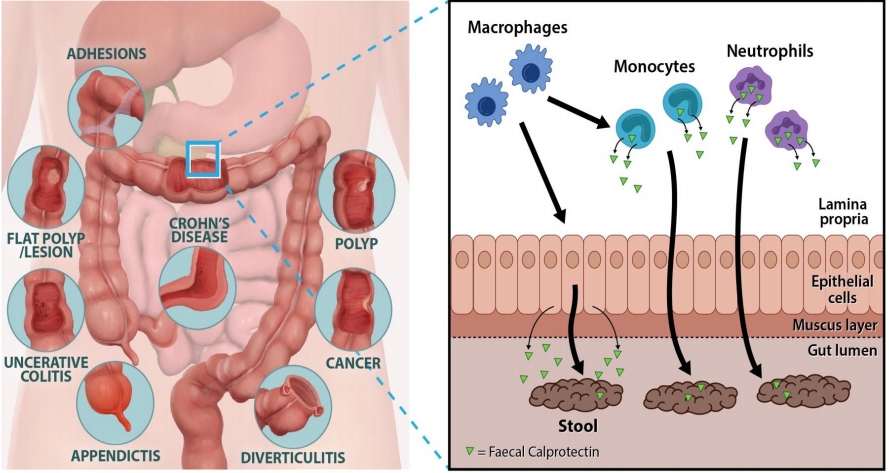
Fecal calprotectin (FC) is a calcium- and zinc-binding protein of the S100 family, mainly expressed by neutrophils and released during inflammation. FC became an increasingly useful tool both for gastroenterologists and for general practitioners for distinguishing inflammatory bowel disease (IBD) from irritable bowel syndrome. Increasing evidences support the use of this biomarker for diagnosis, follow-up and evaluation of response to...
- Original Article
- Developmental and Behavioral Medicine
- Validity of the Korean Developmental Screening Test for very-low-birth-weight infants
- Chae Young Kim, Euiseok Jung, Byong Sop Lee, Ki-Soo Kim, Ellen Ai-Rhan Kim
- Clin Exp Pediatr. 2019;62(5):187-192. Published online March 20, 2019
-
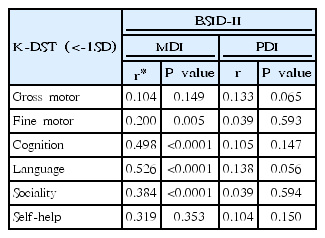
Purpose: The importance of the neurodevelopmental outcomes of very-low-birth-weight (VLBW) infants has been emphasized as their mortality rate has markedly improved. This study aimed to assess the validity of the Korean Developmental Screening Test (K-DST), a developmental screening tool approved by the Korean Society of Pediatrics, for the timely diagnosis of neurodevelopmental delay in VLBW infants. Methods: Subjects included VLBW infants...
- Neonatology (Perinatology)
- The relation between serum levels of epidermal growth factor and necrotizing enterocolitis in preterm neonates
- Heba Mostafa Ahmed, Nsreen Mostafa Kamel
- Clin Exp Pediatr. 2019;62(8):307-311. Published online March 15, 2019
-

Purpose: Necrotizing enterocolitis (NEC) is one of the most serious complications of prematurity. Many risk factors can contribute to the development of NEC. The epidermal growth factor (EGF) plays a major role in intestinal barrier function, increases intestinal enzyme activity, and improves nutrient transport. The aim of this study was to assess the role of epidermal growth factor in the...
- Review Article
- Pulmonology
- Benefits and risks of therapeutic alternatives for macrolide resistant Mycoplasma pneumoniae pneumonia in children
- Hyeon-Jong Yang
- Clin Exp Pediatr. 2019;62(6):199-205. Published online March 15, 2019
-

Although Mycoplasma pneumoniae pneumonia (MPP) has been generally susceptible to macrolides, the emergence of macrolide-resistant MPP (MRMP) has made its treatment challenging. MRMP rapidly spread after the 2000s, especially in East Asia. MRMP is more common in children and adolescents than in adults, which is likely related to the frequent use of macrolides for treating M. pneumoniae infections in children....
- Predictors and management of intravenous immunoglobulin-resistant Kawasaki disease
- Min Seob Song
- Clin Exp Pediatr. 2019;62(4):119-123. Published online March 15, 2019
-

Kawasaki disease (KD) is a systemic vasculitis that mainly affects younger children. Intravenous immunoglobulin (IVIG) resistant cases are at increasing risk for coronary artery complications. The strategy on prediction of potential nonresponders and treatment of IVIG-resistant patients is now controversial. In this review the definition and predictors of IVIG-resistant KD and current evidence to guide management are discussed.
- Original Article
- Other
- Rapidly growing pediatric trampoline-related injuries in Korea: a 10-year single center retrospective study
- Min Jeng Cho, Jihoon Kim, Sung Jeep Kim, Kyu Hyouck Kyoung, Min Ae Keum, Sung Kyun Park
- Clin Exp Pediatr. 2019;62(3):90-94. Published online March 11, 2019
-
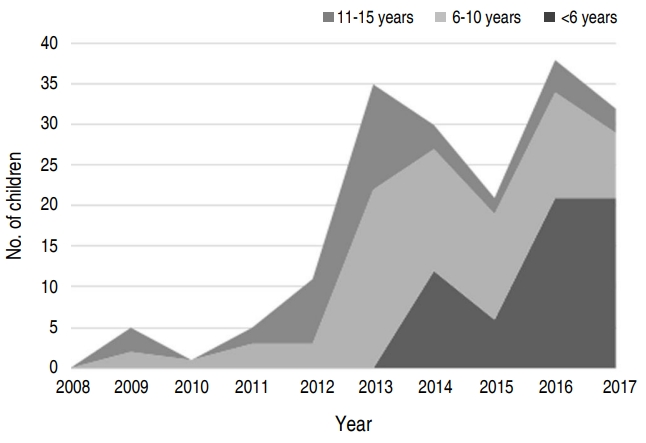
Purpose: Several published policy statements have warned against the risks associated with trampoline use and recommended safety guidelines. However, few studies have focused on trampoline-related injuries in Korea. This study aimed to assess the incidence and characteristics of pediatric trampoline-related injuries presented to Ulsan University Hospital. Methods: We retrospectively reviewed the medical records of children aged <16 years with trampoline-related injuries...
- Review Article
- Trends in the use of antibiotics among Korean children
- Young June Choe, Ju-Young Shin
- Clin Exp Pediatr. 2019;62(4):113-118. Published online March 4, 2019
-
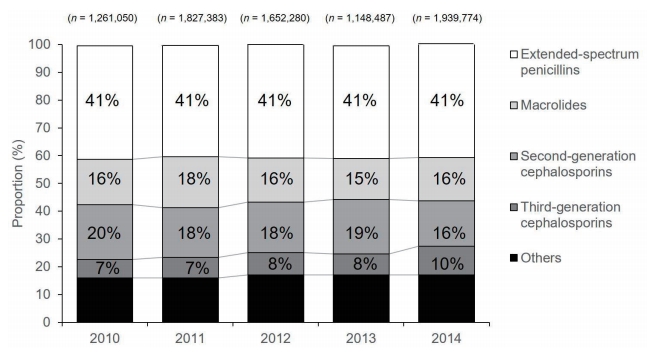
Inappropriate antibiotic use is the most important factor causing increased bacterial resistance to antibiotics, thus affecting patient outcomes. Multidrug-resistant bacteria have become a serious public health threat, causing significant morbidity and mortality worldwide. In Korea, the burden of antibioticresistant bacteria has become an important public health issue. There is increasing evidence of overuse and misuse of antibiotics in Korea, as...
- Original Article
- Endocrinology
- Prevalence and associates of obesity and overweight among school-age children in a rural community of Thailand
- Teechaya Nonboonyawat, Wuttipat Pusanasuwannasri, Nattanon Chanrat, Natta Wongthanavimok, Danutanut Tubngern, Piengkwan Panutrakul, Mathirut Mungthin, Thirapa Nivesvivat, Panadda Hatthachote, Ram Rangsin, Phunlerd Piyaraj
- Clin Exp Pediatr. 2019;62(5):179-186. Published online February 8, 2019
-

Purpose: Information about overweight and obesity among students in rural areas of Thailand is limited. Therefore, we aimed to determine overweight and obesity prevalences and associated factors among school-aged children in a rural community of Thailand. Methods: We selected 9 public schools through cluster sampling in 2 provinces located in central Thailand in 2016. Anthropometric measurements were measured using standard techniques,...
- Review Article
- Neonatology (Perinatology)
- Surfactant preparations for preterm infants with respiratory distress syndrome: past, present, and future
- Ga Won Jeon
- Clin Exp Pediatr. 2019;62(5):155-161. Published online February 8, 2019
-

Following the first successful trial of surfactant replacement therapy for preterm infants with respiratory distress syndrome (RDS) by Fujiwara in 1980, several animal-derived natural surfactants and synthetic surfactants have been developed. Synthetic surfactants were designed to overcome limitations of natural surfactants such as cost, immune reactions, and infections elicited by animal proteins contained in natural surfactants. However, first-generation synthetic surfactants...
- Nutrition
- A perspective on partially hydrolyzed protein infant formula in nonexclusively breastfed infants
- Yvan Vandenplas, Zakiudin Munasir, Badriul Hegar, Dewi Kumarawati, Ahmad Suryawan, Muzal Kadim, Julistio Tb Djais, Ray Wagiu Basrowi, Deni Krisnamurti
- Clin Exp Pediatr. 2019;62(5):149-154. Published online January 14, 2019
-
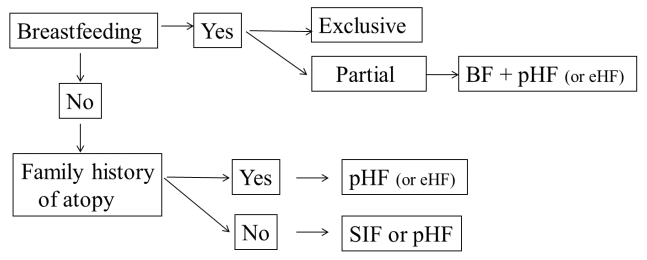
The World Health Organization recommends that infants should be exclusively breastfed for the first 6 months of life to provide optimal nutrition in this critical period of life. After this, infants should receive nutritionally adequate and safe complementary foods while breastfeeding continues for up to 2 years of age or beyond. For nonbreastfed infants, infant formula is an available option...
- Original Article
- Neurology
- Efficacy and tolerability of adjunctive perampanel treatment in children under 12 years of age with refractory epilepsy
- Yuni Yun, Dongsub Kim, Yun-Jeong Lee, Soonhak Kwon, Su-Kyeong Hwang
- Clin Exp Pediatr. 2019;62(7):269-273. Published online December 26, 2018
-

Purpose: There is limited data on the use of perampanel in children under 12 years of age. We evaluated the efficacy and tolerability of adjunctive perampanel treatment in children under 12 years of age with refractory epilepsy. Methods: This retrospective observational study was performed in Kyungpook National University Hospital from July 2016 to March 2018. A responder was defined as a...
- The association between preeclampsia and autism spectrum disorders among children: a meta-analysis
- Ensiyeh Jenabi, Manoochehr Karami, Salman Khazaei, Saeid Bashirian
- Clin Exp Pediatr. 2019;62(4):126-130. Published online December 24, 2018
-
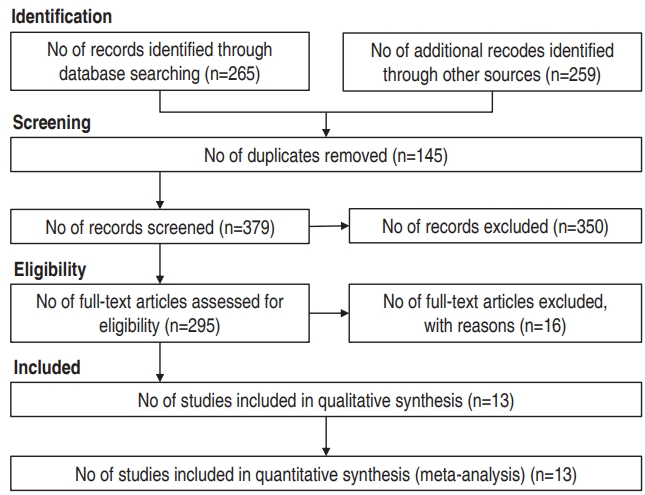
Purpose: In this meta-analysis, relevant case-control and cohort studies were pooled to evaluate the association between preeclampsia and the risk of autism spectrum disorders (ASDs) in children. Methods: A search for relevant studies in major databases, including Web of Science, PubMed, and Scopus, was performed up to May 2018. The odds ratios (ORs) or rate ratios (RRs) with 95% confidence intervals...
- Review Article
- Endocrinology
- The adiposity rebound in the 21st century children: meaning for what?
- Min Jae Kang
- Clin Exp Pediatr. 2018;61(12):375-380. Published online December 6, 2018
-

With the increase in the prevalence of overweight and obesity worldwide, early adiposity rebound, which is known to have a strong association with obesity, has recently been a focus of research. Early adiposity rebound is conventionally known to have a close relationship with non-communicable diseases. However, novel insights into early adiposity rebound have implied an acceleration of growth and puberty,...
- Case Report
- Nephrology (Genitourinary)
- De novo mutations in COL4A5 identified by whole exome sequencing in 2 girls with Alport syndrome in Korea
- Kyoung Hee Han, Jong Eun Park, Chang-Seok Ki
- Clin Exp Pediatr. 2019;62(5):193-197. Published online November 26, 2018
-

Alport syndrome (ATS) is an inherited glomerular disease caused by mutations in one of the type IV collagen novel chains (α3, α4, and α5). ATS is characterized by persistent microscopic hematuria that starts during infancy, eventually leading to either progressive nephritis or end-stage renal disease. There are 3 known genetic forms of ATS, namely X-linked ATS, autosomal recessive ATS, and...
- Original Article
- Risk factors for the occurrence and persistence of coronary aneurysms in Kawasaki disease
- Soo-kyeong Jeon, Geena Kim, Hoon Ko, Joung-Hee Byun, Hyoung Doo Lee
- Clin Exp Pediatr. 2019;62(4):138-143. Published online November 22, 2018
-

Purpose: Prognostic factors of coronary aneurysms in Kawasaki disease have been investigated in many studies. The aim of this study was to identify risk factors associated with early and late coronary artery outcomes in treated patients with Kawasaki disease. Methods: A total of 392 patients diagnosed with Kawasaki disease from January 2012 to December 2015 in Pusan National University Children’s Hospital...
- Case Report
- Infection
- Scabies mimicking graft versus host disease in a hematopoietic cell transplant recipient
- Dongsub Kim, Soo-Han Choi, Dong Youn Lee, Juyoun Kim, Eunjoo Cho, Keon Hee Yoo, Hong Hoe Koo, Yae-Jean Kim
- Clin Exp Pediatr. 2018;61(11):371-373. Published online November 9, 2018
-
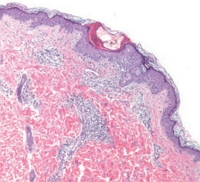
Scabies is a highly contagious skin infestation caused by the mite, Sarcoptes scabiei var. hominis. Complex responses to scabies mites in the innate, humoral, and cellular immune systems can cause skin inflammation and pruritus. Diagnosis can be challenging because scabies resembles other common skin conditions. We report the first Korean case of scabies in a hematopoietic cell transplant (HCT) recipient,...
- Original Article
- Cardiology
- High antistreptolysin O titer is associated with coronary artery lesions in patients with Kawasaki disease
- Dong Eun Min, Do Hee Kim, Mi Young Han, Sung Ho Cha, Kyung Lim Yoon
- Clin Exp Pediatr. 2019;62(6):235-239. Published online November 7, 2018
-

Purpose: In Kawasaki disease (KD) patients, coronary artery complications, incomplete and refractory types occur more frequently in patients with streptococcal or other bacterial/viral infections. Recently, we observed a higher incidence of coronary lesions in KD patients with high anti-streptolysin O (ASO) titer. Therefore, we hypothesized that KD patients diagnosed with concurrent streptococcal infection have poor prognosis, with respect to treatment...
- Review Article
- Nephrology (Genitourinary)
- Renal replacement therapy in neonates with an inborn error of metabolism
- Heeyeon Cho
- Clin Exp Pediatr. 2019;62(2):43-47. Published online November 7, 2018
-

Hyperammonemia can be caused by several genetic inborn errors of metabolism including urea cycle defects, organic acidemias, fatty acid oxidation defects, and certain disorders of amino acid metabolism. High levels of ammonia are extremely neurotoxic, leading to astrocyte swelling, brain edema, coma, severe disability, and even death. Thus, emergency treatment for hyperammonemia must be initiated before a precise diagnosis is...
- Allergy
- Particulate matter and childhood allergic diseases
- Song-I Yang
- Clin Exp Pediatr. 2019;62(1):22-29. Published online November 7, 2018
-
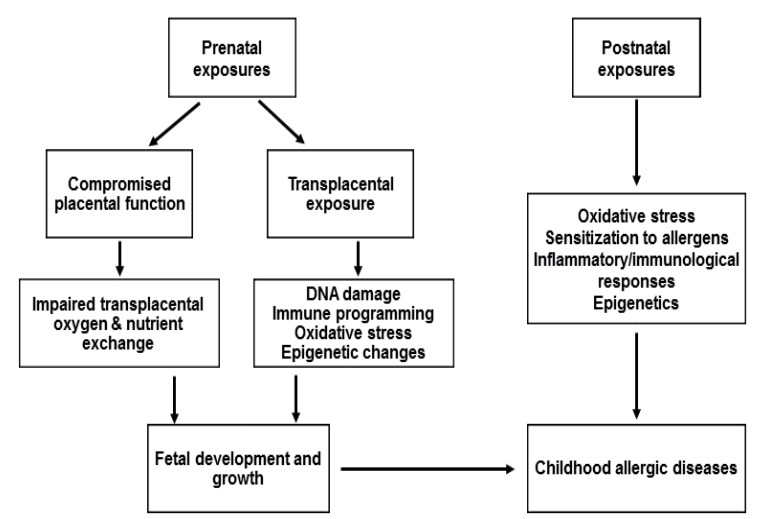
Particulate matter (PM) is a ubiquitous air pollutant that is a growing public health concern. Previous studies have suggested that PM is associated with asthma development and exacerbation of asthma symptoms. Although several studies have suggested increased risks of atopic dermatitis, allergic rhinitis, and allergic sensitization in relation to PM exposure, the evidence remains inconsistent. The plausible mechanisms underlying these...
- Case Report
- Allergy
- Drug eruption by antihistamine mistaken for chronic urticaria in a child
- Gun Moo Lee, Shou-Yu Chu, Sung Yeon Kang, Hyo-Bin Kim, Jin-Sung Park, Ja Kyoung Kim
- Clin Exp Pediatr. 2019;62(2):75-78. Published online October 30, 2018
-
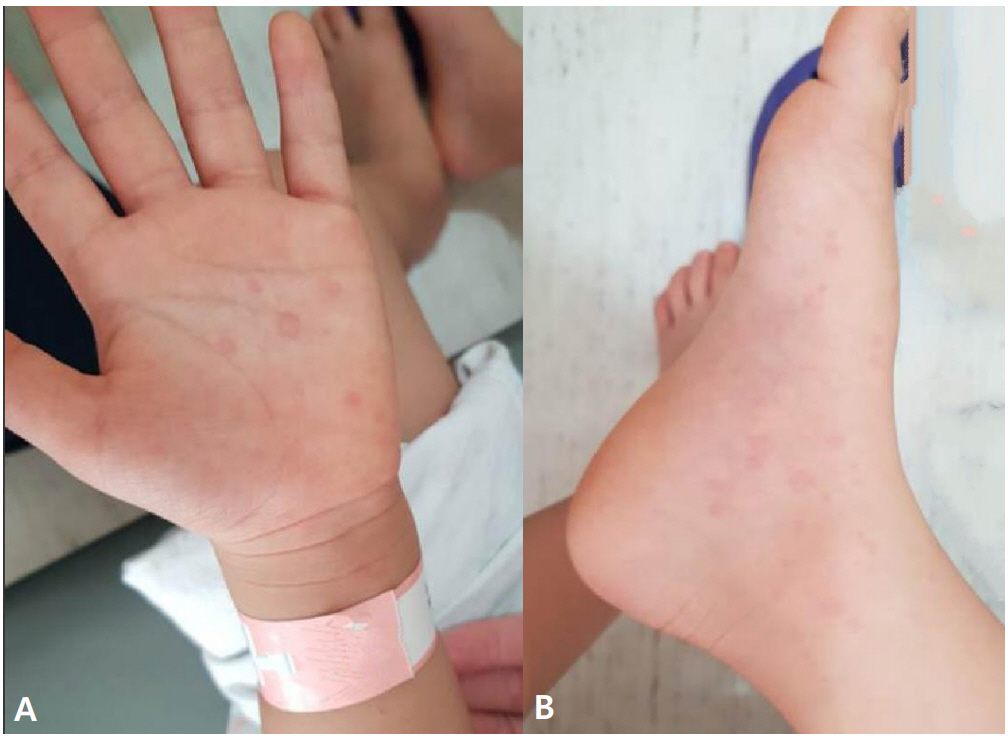
Although rare, antihistamines can cause adverse effects, including drug-induced eruptions or anaphylaxis. A 4-year-old child visited the pediatric department of a hospital for skin eruptions after administration of antihistamines, (e.g., ucerax [hydroxyzine] or leptizine [levocetirizine]), for cholinergic rashes; he did not have pruritus. Skin prick, intradermal, and drug provocation tests were performed to determine the relationship between the antihistamines and...
- Reninoma: a rare cause of curable hypertension
- Ji Hye Kim, Ji Hyun Kim, Myung Hyun Cho, Eujin Park, Hye Sun Hyun, Yo Han Ahn, Hee Gyung Kang, Kyung Chul Moon, Il-Soo Ha, Hae Il Cheong
- Clin Exp Pediatr. 2019;62(4):144-147. Published online October 29, 2018
-
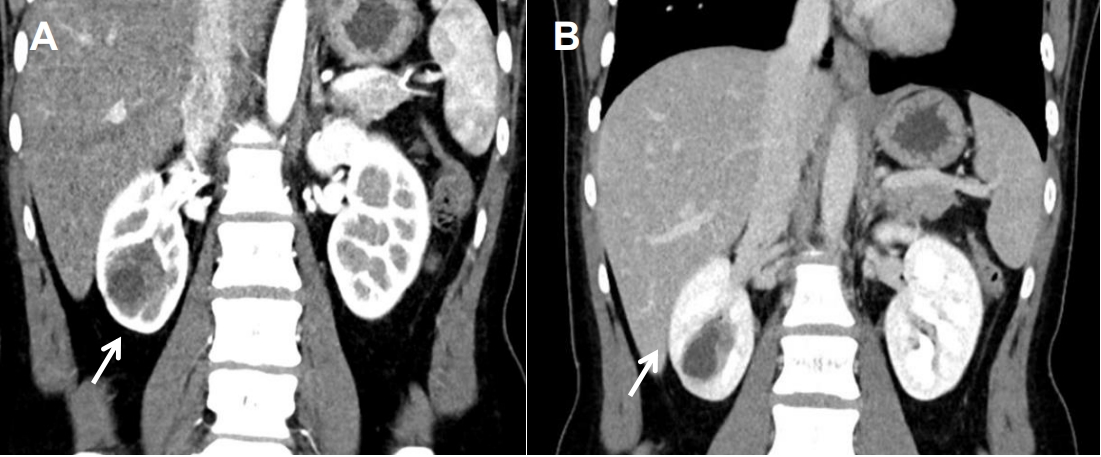
The most common type of refractory hypertension found in children is secondary hypertension, which is a potentially curable disease. Reninoma, a renin-secreting juxtaglomerular cell tumor, is a rare cause of severe hypertension that is usually diagnosed in adolescents and young adults. Surgical resection of the tumor completely cures the hypertension of patients with reninoma. The typical clinical presentation of reninoma...
- Original Article
- Cardiology
- The improvement of right ventricular function after adenotonsillectomy in children with obstructive sleep apnea
- Dong Yeop Kim, Kyung Ok Ko, Jae Woo Lim, Jung Min Yoon, Young Hwa Song, Eun Jeong Cheon
- Clin Exp Pediatr. 2018;61(12):392-396. Published online October 26, 2018
-
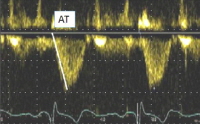
Purpose: Adenotonsillar hypertrophy (ATH) that causes upper airway obstruction might lead to chronic hypoxemic pulmonary vasoconstriction and right ventricular (RV) dysfunction. We aimed to evaluate whether adenotonsillectomy (T&A) in children suffering from obstructive sleep apnea (OSA) due to severe ATH could improve RV function. Methods: Thirty-seven children (boy:girl=21:16; mean age, 9.52±2.20 years), who underwent T&A forsleep apnea due to ATH, were...
- Neonatology (Perinatology)
- Association between vitamin D level at birth and respiratory morbidities in very-low-birth-weight infants
- Ian Kim, Sung Shin Kim, Jee In Song, Seock Hwa Yoon, Ga Young Park, Yong-Wha Lee
- Clin Exp Pediatr. 2019;62(5):166-172. Published online October 24, 2018
-
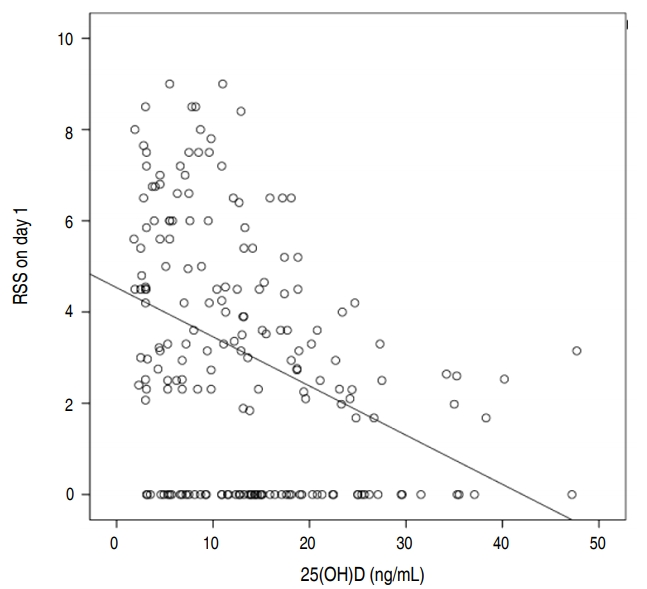
Purpose: This study aimed to evaluate vitamin D status at birth in very-low-birth-weight infants (VLBWIs: <1,500 g) and to determine the association between vitamin D level and respiratory morbidity. Methods: A retrospective study was conducted at Soonchunhyang University Bucheon Hospital between November 2013 and November 2017. We collected blood samples and data on respiratory morbidity from 230 VLBWIs on the first...
- Cardiology
- Changes of Bax, Bcl-2, CCR-2, MCP-1, and TGF-β1 genes in the left ventricle of spontaneously hypertensive rat after losartan treatment
- Hyeryon Lee, Kwan Chang Kim, Young Mi Hong
- Clin Exp Pediatr. 2019;62(3):95-101. Published online October 24, 2018
-

Purpose: Increased apoptosis was recently found in the hypertrophied left ventricle of spontaneously hypertensive rats (SHRs). Although the available evidence suggests that apoptosis can be induced in cardiac cells by various insults including pressure overload, cardiac apoptosis appears to result from an exaggerated local production of angiotensin in adult SHRs. Altered expressions of Bcl associated X (Bax), Bcl-2, chemokine receptor...
- The change of QRS duration after pulmonary valve replacement in patients with repaired tetralogy of Fallot and pulmonary regurgitation
- Yuni Yun, Yeo Hyang Kim, Jung Eun Kwon
- Clin Exp Pediatr. 2018;61(11):362-365. Published online October 24, 2018
-
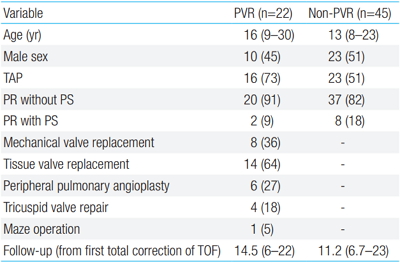
Purpose: This study aimed to analyze changes in QRS duration and cardiothoracic ratio (CTR) following pulmonary valve replacement (PVR) in patients with tetralogy of Fallot (TOF). Methods: Children and adolescents who had previously undergone total repair for TOF (n=67; median age, 16 years) who required elective PVR for pulmonary regurgitation and/or right ventricular out tract obstruction were included in this study....
- Respiratory syncytial virus-associated seizures in Korean children, 2011–2016
- Teahyen Cha, Young Jin Choi, Jae-Won Oh, Chang-Ryul Kim, Dong Woo Park, In Joon Seol, Jin-Hwa Moon
- Clin Exp Pediatr. 2019;62(4):131-137. Published online October 23, 2018
-

Purpose: Respiratory syncytial virus (RSV) infection can cause various neurological complications. This study aimed to investigate the RSV-associated neurologic manifestations that present with seizures. Methods: We retrospectively reviewed the medical records of patients aged less than 15 years with laboratory-confirmed RSV infections and seizures between January 2011 and December 2016 in a regional hospital in South Korea. Results: During this period, 1,193...
- Review Article
- Nephrology (Genitourinary)
- Acute kidney injury and continuous renal replacement therapy in children; what pediatricians need to know
- Myung Hyun Cho, Hee Gyung Kang
- Clin Exp Pediatr. 2018;61(11):339-347. Published online October 23, 2018
-
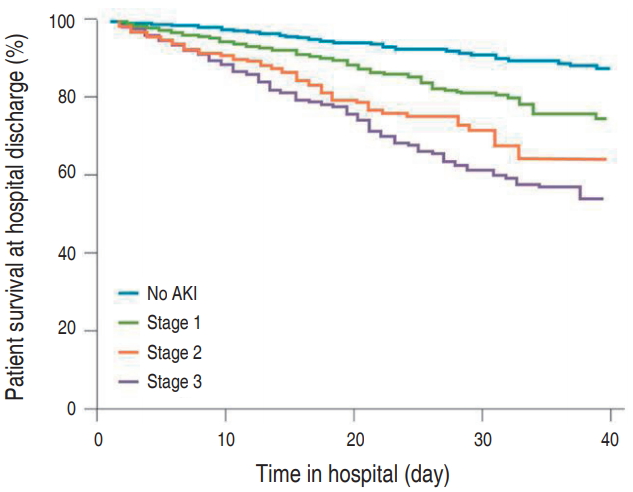
Acute kidney injury (AKI) is characterized by abrupt deterioration of renal function, and its diagnosis relies on creatinine measurements and urine output. AKI is associated with higher morbidity and mortality, and is a risk factor for development of chronic kidney disease. There is no proven medication for AKI. Therefore, prevention and early detection are important. Physicians should be aware of...
- Original Article
- Neonatology (Perinatology)
- Diagnostic value of eosinopenia and neutrophil to lymphocyte ratio on early onset neonatal sepsis
- Rocky Wilar
- Clin Exp Pediatr. 2019;62(6):217-223. Published online October 8, 2018
-
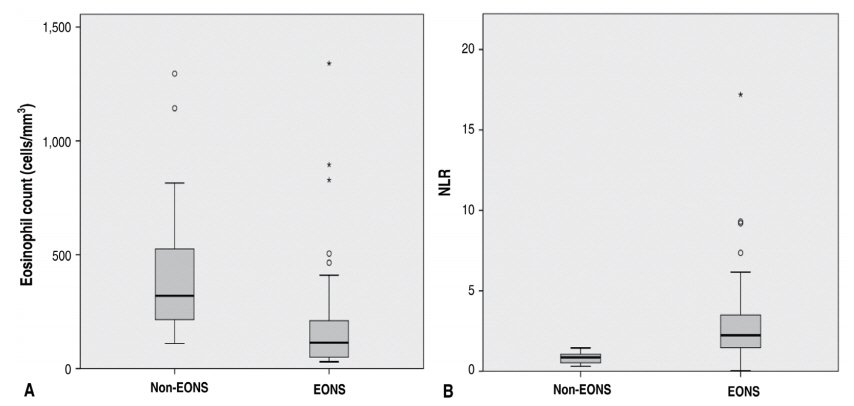
Purpose: To determine the diagnostic value of eosinopenia and the neutrophil-to-lymphocyte ratio (NLR) in the diagnosis of early onset neonatal sepsis (EONS). Methods: This cross-sectional study was conducted in the Neonatology Ward of R.D. Kandou General Hospital Manado between July and October 2017. Samples were obtained from all neonates meeting the inclusion criteria for EONS. Data were encoded using logistic regression...
- Genetics and Metabolism
- Clinical and molecular characterization of Korean children with infantile and late-onset Pompe disease: 10 years of experience with enzyme replacement therapy at a single center
- Min-Sun Kim, Ari Song, Minji Im, June Huh, I-Seok Kang, Jinyoung Song, Aram Yang, Jinsup Kim, Eun-Kyung Kwon, Eu-Jin Choi, Sun-Ju Han, Hyung-Doo Park, Sung Yoon Cho, Dong-Kyu Jin
- Clin Exp Pediatr. 2019;62(6):224-234. Published online October 4, 2018
-

Purpose: Pompe disease (PD) is an autosomal recessive disorder caused by a deficiency of acid alphaglucosidase resulting from pathogenic GAA variants. This study describes the clinical features, genotypes, changes before and after enzyme replacement therapy (ERT), and long-term outcomes in patients with infantile-onset PD (IOPD) and late-onset PD (LOPD) at a tertiary medical center. Methods: The medical records of 5 Korean...
- Nephrology (Genitourinary)
- Changes in the thyroid hormone profiles in children with nephrotic syndrome
- Sun Hee Jung, Jeong Eun Lee, Woo Yeong Chung
- Clin Exp Pediatr. 2019;62(3):85-89. Published online October 4, 2018
-
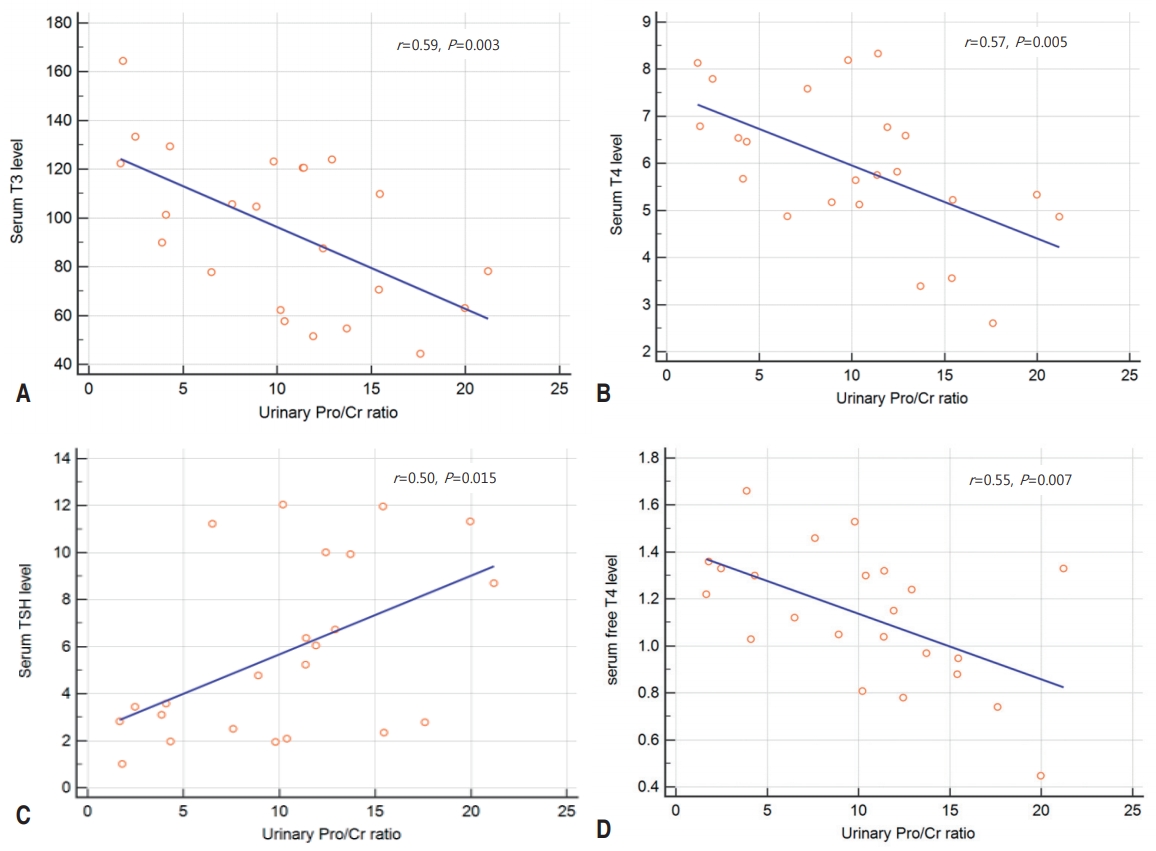
Purpose: We compared thyroid hormone profiles in children with nephrotic syndrome (NS) during the nephrotic phase and after remission. Methods: This study included 31 pediatric NS patients. The thyroid hormone profiles included serum levels of triiodothyronine (T3), thyroxine (T4), thyroid-stimulating hormone (TSH), and free T4. Results: Of the 31 patients, 16 (51.6%) showed abnormal thyroid hormone profiles: 6 had overt hypothyroidism, 8...
-

-
-
Impact Factor3.2
-
8.02023CiteScore94th percentilePowered by
-









